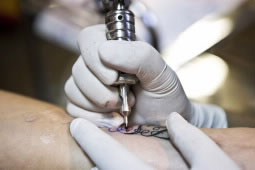Open for Discussion: Tattoos
By Barbara Sitzman and Regis Goode
Thinking about tattoos?

Once popularized by cartoon characters, tattoos are everywhere now. Just look at the reality show “Miami Ink,” magazine advertisements for Calvin Klein, or celebrities such as David Beckham, Johnny Depp, and Katy Perry. Have you also noticed inked torsos during basketball and football seasons? The Pew Research Center reports that 38% of young adults ages 18 to 29 have tattoos.
How are tattoos made?
Needles puncture through two layers of skin, injecting droplets of ink. Jabs are repeated close together, forming a pattern. Since the ink is inserted deeply into the second layer of skin, it remains stable, so the tattoo is essentially permanent.
If you decide to ink, do it safely by seeing an expert. Ask if the tattoo artists are licensed, wear gloves, and sterilize their instruments. Since a new tattoo is a wound, treat it like one. Infection and diseases are potential problems.
What’s in the ink?
Most tattoo inks are pigments suspended in a carrier solution that keeps the color pigments evenly distributed for smooth application. Salts of heavy metals are usually the source of color for the inks (Table 1). The heavy metals mercury, lead, and cadmium are known to cause brain damage, birth defects, and other serious medical problems.
When ink is carefully and safely deposited in the skin, it usually does not cause a problem, but if the body has an allergic reaction to the ink or carrier, chemical changes can occur that lead to an itchy rash or small bumps.
| COLORS | METALS (symbol) |
|---|---|
| Black | Iron (Fe), Carbon (C) |
| Brown | Iron (Fe) rust |
| Red | Mercury (Hg), Cadmium (Cd) |
| Orange | Cadmium (Cd) |
| Yellow | Zinc (Zn), Cadmium (Cd) |
| Green | Chromium (Cr), Copper (Cu), Lead (Pb), Aluminum (Al) |
| Blue | Cobalt (Co), Copper (Cu), Iron (Fe) |
| Violet | Manganese (Mn), Aluminum (Al) |
| White | Lead (Pb), Titanium (Ti), Barium (Ba), Zinc (Zn) |
Can tattoos be removed?
You can’t just cut or rub away a tattoo. Consider a tattoo as a lifelong decoration. Sometimes tattoos can be removed by repeated laser treatments performed by a doctor. When the laser’s intense light energy is focused on a tattoo, the ink pigments break into tiny, nanosized particles that are gradually absorbed by the body. This is a painfully slow and expensive process, costing $1,000, or more, depending on the tattoo.
Why not experiment with alternatives?
With all the cost, pain, and risks involved, why not do a trial tattoo first? This can be fun. Ink your body temporarily before attempting the real thing. You can order supplies online and host a glittery tattoo party at your home. If you decide to ink, do the research, and then look at the data to make an informed decision.

